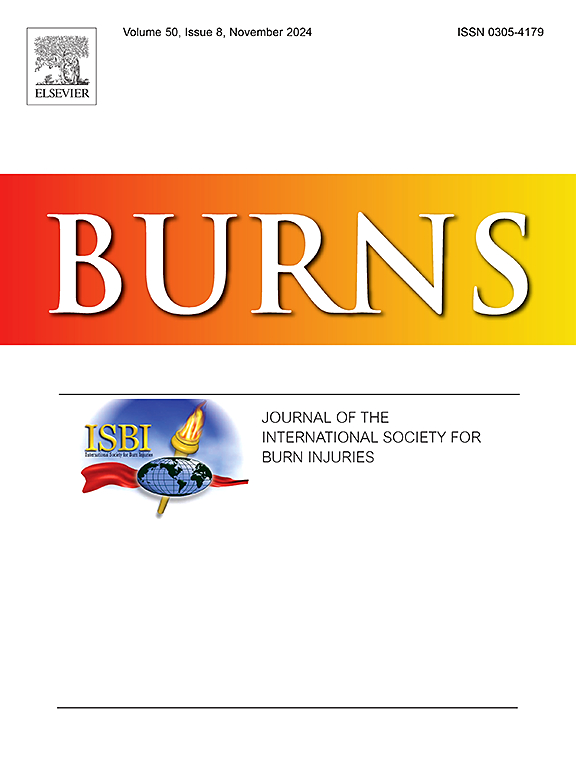Population pharmacokinetics and dosing optimisation of polymyxin B in patients with severe burns
IF 2.9
3区 医学
Q2 CRITICAL CARE MEDICINE
引用次数: 0
Abstract
Objective
Data on polymyxin B (PMB) pharmacokinetics (PK) in patients with severe burns are scarce. We aimed to develop a population PK (PopPK) model for PMB in this population, identify factors influencing PK parameters, and optimise dosing regimens.
Methods
Plasma concentrations were measured using ultra-performance liquid chromatography–tandem mass spectrometry. PopPK modelling was performed with nonlinear mixed-effects modelling (NONMEM). Monte Carlo simulations were used to design PMB regimens targeting an optimal therapeutic window (AUCss, 24 h, 50–100 mg·h·L⁻¹) and a PK/pharmacodynamic threshold of AUCss, 24 h/MIC > 50, with a ≥ 90 % probability of target attainment (PTA).
Results
A total of 118 PMB concentrations from 53 patients were analysed. A one-compartment model with first-order elimination was used to describe the data. Blood urea nitrogen (BUN) was a significant covariate, showing a negative correlation with clearance. Loading doses had a minimal effect on PTA or the proportion of patients achieving an AUCss, 24 h within the therapeutic window. At minimum inhibitory concentration (MIC) ≤ 0.5 mg·L⁻¹ , a 75 mg q12h regimen achieved > 90 % PTA with low risk of supratherapeutic exposure (AUCss, 24 h > 100 mg·h·L⁻¹). At MIC 1 mg·L⁻¹ , only the 100 mg q12h regimen in patients with moderate-to-high BUN achieved ≥ 90 % PTA.
Conclusion
Overall, this study provides PK insights into PMB dosing in patients with severe burns, supporting 75 mg q12h (for MIC ≤ 0.5 mg·L⁻¹) as an effective regimen. Regular BUN monitoring and therapeutic drug monitoring are recommended for personalised dosing.
重度烧伤患者多粘菌素B的人群药代动力学及剂量优化。
目的:重度烧伤患者多粘菌素B (PMB)药代动力学(PK)资料较少。我们的目标是在该种群中建立PMB的种群PK (PopPK)模型,确定影响PK参数的因素,并优化给药方案。方法:采用超高效液相色谱-串联质谱法测定血浆浓度。采用非线性混合效应模型(NONMEM)对PopPK进行建模。使用蒙特卡罗模拟来设计PMB方案,针对最佳治疗窗口(aucs,24 h, 50-100 mg·h·L⁻¹)和PK/药效学阈值aucs,24 h/MIC > 50,目标实现概率(PTA)≥ 90 %。结果:分析了53例患者的118个PMB浓度。采用一阶消去的单室模型来描述数据。血尿素氮(BUN)是显著协变量,与清除率呈负相关。在治疗窗口内,负荷剂量对PTA或达到auss的患者比例的影响最小,为24 h。在最低抑制浓度(MIC)≤ 0.5 mg·h·L⁻¹ 时,75 mg q12h的方案达到了> 90 %的PTA,并且具有低的超治疗暴露风险(auss,24 h > 100 mg·h·L⁻¹)。在MIC 1 mg·L⁻¹ ,只有中高BUN患者的100 mg q12h方案达到≥ 90 % PTA。结论:总的来说,这项研究为重度烧伤患者的PMB剂量提供了PK见解,支持75 mg·L - 12小时(MIC≤0.5 mg·L - 1)是一种有效的方案。建议进行定期BUN监测和治疗药物监测,以实现个体化给药。
本文章由计算机程序翻译,如有差异,请以英文原文为准。
求助全文
约1分钟内获得全文
求助全文
来源期刊

Burns
医学-皮肤病学
CiteScore
4.50
自引率
18.50%
发文量
304
审稿时长
72 days
期刊介绍:
Burns aims to foster the exchange of information among all engaged in preventing and treating the effects of burns. The journal focuses on clinical, scientific and social aspects of these injuries and covers the prevention of the injury, the epidemiology of such injuries and all aspects of treatment including development of new techniques and technologies and verification of existing ones. Regular features include clinical and scientific papers, state of the art reviews and descriptions of burn-care in practice.
Topics covered by Burns include: the effects of smoke on man and animals, their tissues and cells; the responses to and treatment of patients and animals with chemical injuries to the skin; the biological and clinical effects of cold injuries; surgical techniques which are, or may be relevant to the treatment of burned patients during the acute or reconstructive phase following injury; well controlled laboratory studies of the effectiveness of anti-microbial agents on infection and new materials on scarring and healing; inflammatory responses to injury, effectiveness of related agents and other compounds used to modify the physiological and cellular responses to the injury; experimental studies of burns and the outcome of burn wound healing; regenerative medicine concerning the skin.
 求助内容:
求助内容: 应助结果提醒方式:
应助结果提醒方式:


